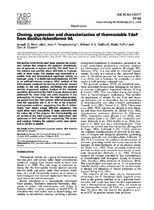Cloning, expression and characterization of thermostable YdaP from Bacillus licheniformis 9A
Date
2017Author
Lako, Joseph D. Wani
Yengkopiong, Jada P.
Stafford, William H. L.
Tuffin, Marla
Cowan, Don A.
Metadata
Show full item recordAbstract
The Bacillus licheniformis ydaP gene encodes for a pyruvate
oxidase that catalyses the oxidative decarboxylation
of pyruvate to acetate and CO2. The YdaP form of
this enzyme was purified about 48.6-folds to homogeneity
in three steps. The enzyme was recovered in a
soluble form and demonstrated significant activity on
pyruvate using 2, 6-dichlorophenolindophenol (DCPIP)
as an artificial electron acceptor. HPLC analysis of the
YdaP-enzyme catalysed conversion of pyruvate showed
acetate as the sole product, confirming the putative
identity of pyruvate oxidase. Analysis of the substrate
specificity showed that the YdaP enzyme demonstrated
preference for short chain oxo acids; however, it was
activated by 1% Triton X-100. The YdaP substrate-binding
pocket from the YdaP protein differed substantially
from the equivalent site in all of the so far characterized
pyruvate oxidases, suggesting that the B. licheniformis
YdaP might accept different substrates. This
could allow more accessibility of large substrates into
the active site of this enzyme. The thermostability and
pH activity of the YdaP enzyme were determined, with
optimums at 50ºC and pH 5.8, respectively. The amino
acid residues forming the catalytic cavity were identified
as Gln460 to Ala480.

